

My Hajj Experience
Sheila Musaji
Posted Nov 5, 2011 •Permalink • Printer-Friendly VersionMY HAJJ EXPERIENCE
by Sheila Musaji
According to a Hadith the Prophet said: Did you not know that Islam wipes out what came before it, and that Hijrah wipes out what came before it and that Hajj wipes out what came before it! (Sahih Muslim).
Hajj is one of the five pillars of Islam. It’s rituals have been the same since the time of Abraham. Hajj is a journey into the past. In remembering the history of hajj - walking in the paths of Adam and Eve, Abraham and Hajjar, Prophet Muhammad, and all who have gone before Hajj reminds us that life is a journey.
Abu Sha’thaa’ said, I contemplated the good deeds that a person does. I found that salaat as well as fasting are a jihad of the body. And that sadaqa is a jihad of someone’s wealth. But Hajj is a jihad of both body and wealth.
The prayer of the one in Hajj shall be accepted. The Prophet (Peace be upon him) said, The soldier in the path of Allah and the one who performs Hajj and the one who performs Umrah, all are the delegation of Allah! He called them and they answered. And they asked Him, and He shall grant them (what they ask for)! (Authentic, narrated by Ibn Majah and Ibn Hibban).
Before leaving for Hajj we are required to draw up a will, settle our financial affairs, make amends to anyone we have wronged - just as if we are preparing to die.
You and every organ of your body are responsible for your deeds. While you are in this “house of correction” get ready for the “house of justice”. Exercise death before you die-go to Hajj! (Qur’an 17:36)
Muslims believe that all of those who come for the pilgrimage have been “invited” and are the guests of God. For those who are invited everything will work out, they will get the necessary visas and make the arrangements and come to God’s house. Whatever they experience will contain a lesson and the lessons will be different for each person.
| I had been thinking about Hajj since a trip to Egypt where I saw many Hajj paintings on houses and the obvious joy expressed in them caught my attention. I thought about it on and off but then this year the desire to go finally became an intention to go. I was “invited” in 2005 but began with more questions than answers, and had more than a little apprehension. Why have I been invited? What am I supposed to learn? How will I know if I have been successful in my Hajj? Nevertheless, I made the intention and began the journey. “Labbayka Allahumma Labbayk”, “God I’m here at your service.” |  |
Hajj is supposed to be a challenging experience. In the past the challenges were physical - the journey might take months or even years. There were no facilities except for those you brought yourself. Today, we can fly, there are hotels and food and water are provided. Positively luxurious, and, still it is challenging.
In our case the Hajj was terrible and wonderful. It was terrible because - our Hajj travel agency turned out to be crooked, - flights were changed from major carriers to cheap charters, - hotels were changed from 5-star to third rate hotels (without soap, towels, or even sheets which was only important because of health problems and because we didn’t know to be prepared for such emergencies), - required procedures were not followed resulting in excessive waits, - changes were made with no notice, - we paid for services we did not receive, - some members of our group were robbed by pickpockets, - luggage was lost, - over the course of two weeks we all became ill, - while at Mina we had an unusually heavy rain and flash flood which left our sleeping mats, blankets and pillows soaking wet and washed away our shoes, - the Saudi government moved the date of Hajj forward one day leaving us with an extra day with no place to stay ...
And yet, even with these difficulties and frustrations, Hajj was also wonderful. We were very fortunate to have Shaikh Muhammad Nur Abdullah as our religious advisor and his advice kept us focused.
Hajj was terrible because of the shock in discovering that among the pilgrims were thieves and pickpockets, and that some people were so focused on completing some partiular action that they lost sight of the more important aspect of not harming others, and so they pushed and shoved and got irritated (we even saw a couple of fist fights). It was sometimes difficult to remember that each of us was starting on this journey from a different level of spiritual development. We had all been invited and each of us had an opportunity to learn what was needed for our own personal development, but this opportunity to learn and grow can be presented to us, but the individual needs to be open to the possibility and willing to change and learn.
The Prophet Muhammad (peace be upon him) said: “If you guarantee me six things on your part, I shall guarantee you Paradise. Speak the truth when you talk, keep a promise when you make it, when you are trusted with something fulfill your trust, avoid sexual immorality, lower your gaze (in modesty), and restrain your hands from injustice.” Al-Tirmidhi, Hadith 1260
It was terrible as long as I had expectations about what should be and wonderful when I let go and just exerienced what actually was.
| Before leaving we read as many books as possible, talked to people who had been on Hajj before us, attended classes at the mosque to learn details of the Hajj - we thought we were prepared. But, we learned that nothing can prepare you for the actual event of Hajj. It is something that must be experienced. “Labbayka Allahumma Labbayk”, “God I’m here at your service.” Only Muslims are allowed in the haram (Mecca and Medina). We were told that if you take the Non Moslems lane shown on this freeway sign, then you will go in a large loop and go back the way you came. |  |
We went first to Medina to visit the Prophet’s Mosque. Medina is the sort of place you think of when thinking of a spiritual experience. It is outside of the mundane, quiet and serene, a place for meditating in peaceful surroundings with few distractions.
 |
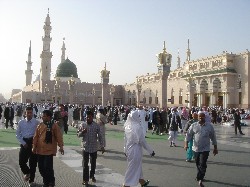 |
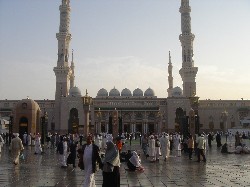 |
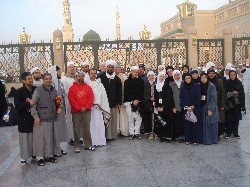 |
| Interior views of Masjid an Nabawi |  |
 |
We visited Masjid Quba and Masjid Qiblatain while we were there. Masjid Quba was the first mosque ever built. Masjid Qiblatain has two Qiblas - one facing Jerusalem and one facing Mecca.
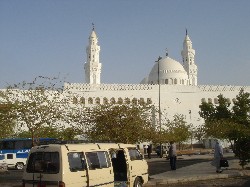 |
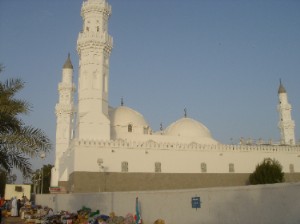 |
| Masjid Quba | Masjid Qiblatain |
We also visited Uhud, and the graveyard where many of the Sahaba who died at the Battle of Uhud are buried including the Prophet’s Uncle Hamza and Musaab.
And we visited the graveyard of Janaat al Baqi
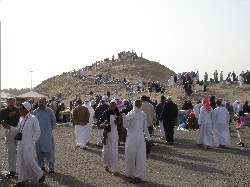 |
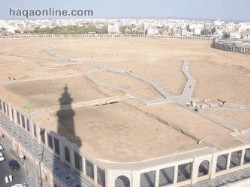 |
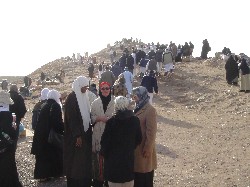 |
| Uhud | Janaat al Baqi | Uhud |
| We come to Mecca by bus after stopping on the way to enter into Ihram. Putting on the white Ihram is the first lesson of Hajj - symbolizing the burial shroud which is all that we will take with us when we die. The first act in Mecca is to go to the Mosque to do our tawaf (going around the Kaaba 7 times in a counter-clockwise direction) and saee (going 7 times between the hills of Safa and Marwa in remembrance of Hajjar’s search for water for Ishmael and herself) for Umrah. Everything here revolves around the Kaaba and so finding it is always easy, just follow the crowds. “Labbayka Allahumma Labbayk”, “God I’m here at your service.” | 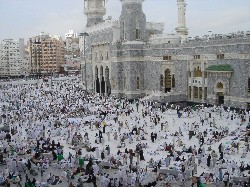 |
| Masjid Haram at Mecca |
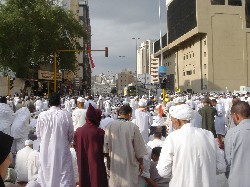 |
Mecca is nothing like Medina. Here I was on the greatest spiritual journey of my life, where I had come to meet God, and the circumstances were nothing like the personal spiritual moments I had envisioned, or that Medina had represented. In Mecca, I was surrounded by noise, dirt, frantic activity, confusion and more people than can be imagined. People of every nationality, speaking hundreds of different languages. So many sounds and smells and so much sensory input that your senses are overloaded. | 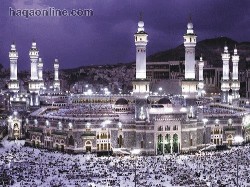 |
| Street scene in Mecca |
For me, crowds are more than a little frightening, even a busy shopping mall can be intimidating. The crowds in Mecca are beyond anything I could imagine.
This Hajj lesson was that to come to terms with God we must come to terms with humanity, even messy, smelly, rude humanity. We must find God in the midst of exuberant life. We must be involved with others and participate in their struggle. We must show compassion and patience.
“Labbayka Allahumma Labbayk”, “God I’m here at your service.”
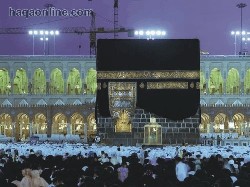 |
I had been told to keep my eyes on the ground and when I knew I could see the Kaaba clearly to look up and say prayers for whatever I wanted to ask God, as it is believed that prayers said the first time you see the Kaaba have special efficacy. When I looked up and saw the actual Kaaba it was overwhelming. Seeing photographs and hearing descriptions don’t come anywhere close to the actual experience. | 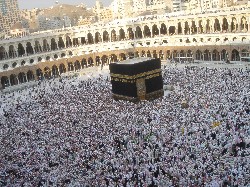 |
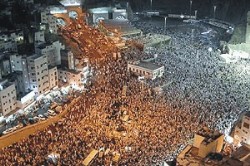 |
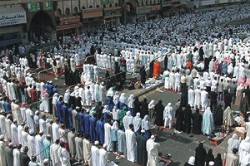 |
One moment it is hectic, people bargaining in the shops, cars honking, too much noise, people talking in every language and suddenly the call to prayer and then the shops close, people hurry to get to the mosque, or when the mosque is full begin lining up on the streets to pray. |
| Mecca street at prayer time | Praying in the street |
| When we did tawaf we were able to get very close to the Maqam Ibrahim - close enough to look inside the glass and see Ibrahim?s footprints. This was really special for me as for all three times I did tawaf I needed to do it in a wheelchair - but my husband asked if I wanted to attempt one tawaf on my own two feet and he would help me. We did it, and he got me as close as we dared to the Kaaba itself. | 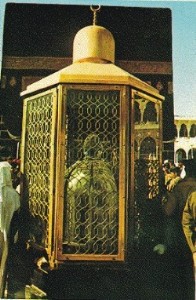 |
| Maqam Ibrahim |
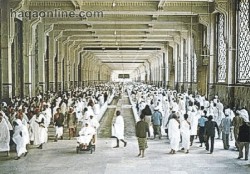 |
Saee between Safa and Marwa - this was another event that was difficult for me to reconcile the spiritual and the actual physical event. Because I did tawaf and saee in a wheelchair I thought initially this would be an advantage because I could focus entirely on the spiritual aspects of the saee and remembering the events it represents - as it turned out the young men who push the wheelchairs are not supervised and sometimes run so fast that they become a danger to others - running over people’s feet, bumping into other wheelchairs and generally being a nuisance. This was distracting and when they caused others to be either hurt or inconvenienced it made me feel terrible. Since they didn’t speak English there wasn’t anything I could do to stop them - and it became a rather frightening experience. This is one part of Hajj that it may be awhile before I discover the lesson to be learned. |
God is One - but God’s people are diverse - thinking about the ultimate oneness of humanity is difficult, but during Hajj the individuals become “mankind”. We turn away from ourselves to find ourselves.
“Labbayka Allahumma Labbayk”, “God I’m here at your service.”
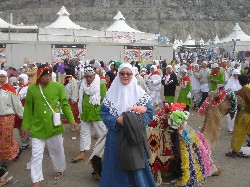 |
We spend four days in Mecca and then leave for Mina by bus. In Mina we will be living in tents. Some people have come with just enough money to get here and have set up their own small tents on the sidewalks or in the hills. Some of us are fortunate and have air conditioned tents with carpets and thick cushions to sleep on. All of us share public bathrooms and showers. There are aso many people who have brought items to sell and who set up shop on blankets lining the walkways. Some people bring their camels and horses for people to take pictures with. | 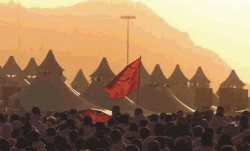 |
| Sheila at Mina | Tents at Mina |
After one day in Mina we go to Arafat after sunrise and remain until sunset.
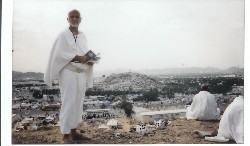 |
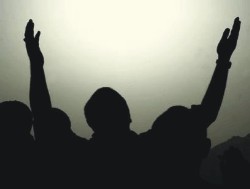 |
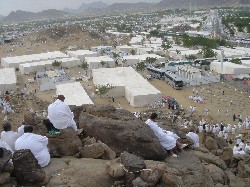 |
| Iqbal Musaji at Arafat |
Allahu Akbar, Allahu Akbar! God is Most Great, God is Most Great!
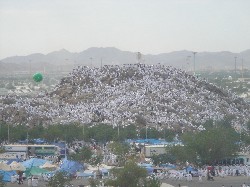 |
There is a Hadith of the Prophet that says: “Arafat is Hajj”. This day spent simply being at Arafat and commiunicating privately with God is one of the most important. One of the hills on the plain of Arafat is Mount Mercy where the Prophet made his farewell speech. Arafat was wonderful. There is nothing particular you are required to do and nothing to do except be there and talk to God. | 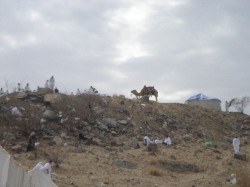 |
| At sunset we leave for Muzdalifah where we collect our 70 pebbles for stoning the devil and where we spend the night sleeping on the ground under the stars. This was for many in our group an eye opening experience - and there was much talk about what it must be like for homeless people who had nowhere else to sleep. | 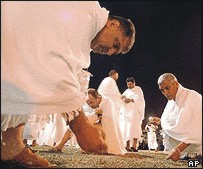 | ||
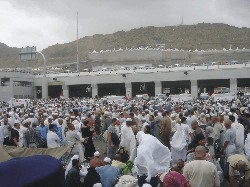 |
In the morning we return to Mina and throw the stones at the largest of the three pillars representing the devil. This is also the day of sacrifice and after that is concluded we cut our hair. Men shave their heads and women just cut off a small length of hair. | ||
| Jamaraat | The next three days at Mina we throw 7 pebbles at each of the three pillars each day. When we symbolically stone the devil we are stoning temptations, and those negative traits and character flaws that separate us from our Creator. Pride, selfishness, greed, fear. | ||
| At Mina we experienced a heavy rainstorm which led to a flashflood and a miserable damp night as all of our possessions were wet. This was our groups kitchen after the flood. | 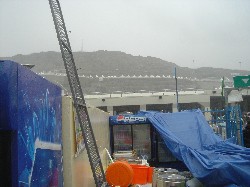 |
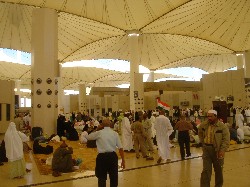 |
Then we went back to Mecca to make the final tawaf and saee, say goodbye to the mosque, and go back to the Hajj Terminal at Jeddah Airport. This is a huge terminal that is used only during the Hajj each year. |
Allahu Akbar, Allahu Akbar! God is Most Great, God is Most Great!
| At the airport we took some group photographs. | |
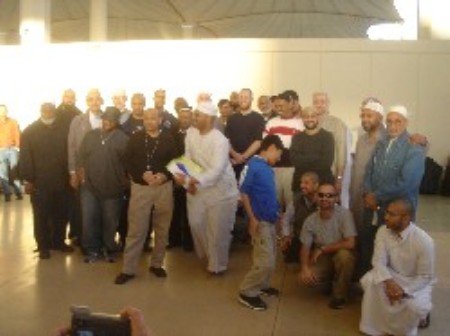 |
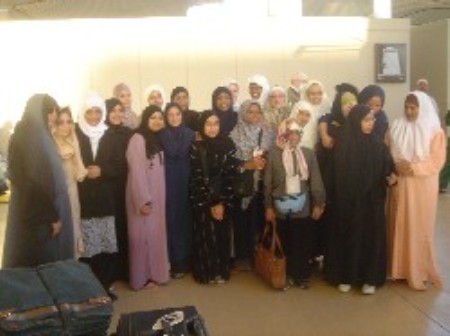 |
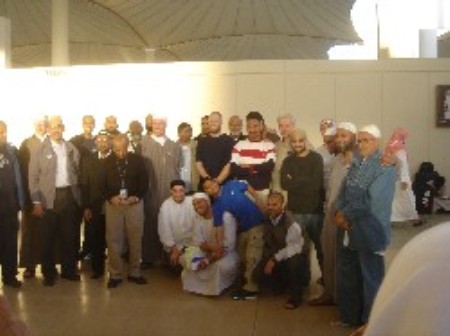 |
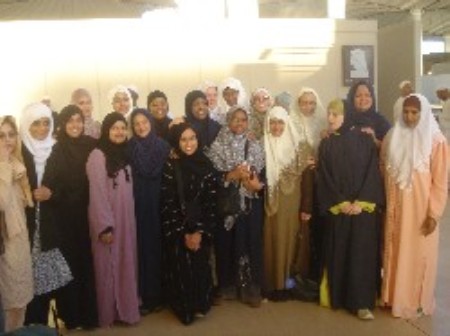 |
After we had been at the airport for 2 days the photographs were a little different., it was cold, and we needed to find relatively comfortable places to sleep. We gained a real feel for how homeless people must feel as we searched for cardboard to put down to sleep on.
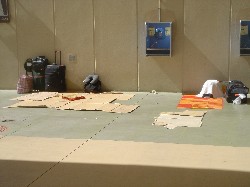 |
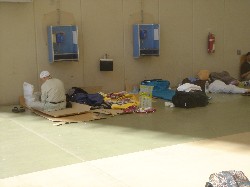 |
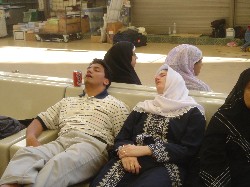 |
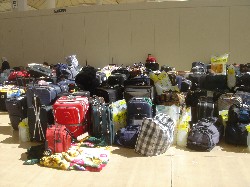 |
| There were shops at the airport and the fellow who was selling blankets must have done one of his best days ever as we all bought blankets from him. | 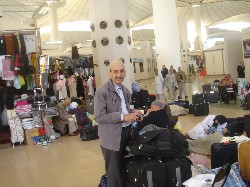 |
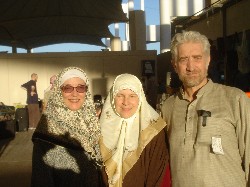 |
One unusual thing was the number of people we knew that we bumped into on Hajj. Old friends from New Mexico were in the same group which we didn’t know until we got there. One of my husband’s cousins from California was also doing Hajj and we bumped into them at the Prophet’s mosque in Medina. |
| Sheila with Karima Alavi & Abdul Raouf deClerk |
What I am left with at the end of the Hajj are vivid memories and many disconnected thoughts. If God is willing, in time these may become connected and more clear.
Before leaving for Hajj I made a list of THINGS TO DO DURING HAJJ - smile at others, say salaam to strangers, show concern for others, share food, tea, fruit, etc. with others, visit with people from other countries and learn about them, help those in difficulty, help others gather stones, lower your gaze, be patient, make dua for others, watch for people who need help, forgive people, compliment others, take candies to give to children that you meet - this list was in the beginning of my small Hajj notebook that I took with me. I am still thinking about how well I did in remembering these things.
When I came to Hajj, I came as an individual, but during the Hajj I continually experienced the powerful sense of connectedness to all of the other individuals and in fact to all of creation. We were separate and yet not separate. In tawaf we are all part of a pattern or design moving with the rhythm of the cosmos, circling what is important
During Hajj millions of individuals came together and were jostled, thrown together, separated, bruised, routines are demolished, individuality is blurred, economic and social distinctions are erased by the Ihram, Here we become a community After 3 or 4 days individuals show their true natures - those traits that are deeply and sincerely imbedded in our character come to the surface and are made visible. Some show frustration and anger, some show helpfulness and compassion who we truly are is made clear to others and to ourselves
Another lesson of Hajj - we are changed and have an opportunity to change, to improve, to see ourselves clearly,
While going around the Kaaba in tawaf our awareness increases that God is the focus and God remains timeless and constant while we (his Creation) change and move and circle. We are spinning around the source of our existence in a kind of moving prayer. During the Hajj there are people making this counter clockwise tawaf around the Kaaba 24 hours of the day and night. Some are joining, some are leaving the circle of motion but the motion never ceases.
One difficulty I had was that I was told many times - if you pray here it is equal to 50,000 prayers elsewhere, or if you carry out a particular action in this place at this time it will somehow give you “extra points” on the day of judgement - I tend to reject such a simplistic idea which reminds me of the old Christian practice of indulgences. It seems to me that these statements are symbolic of the importance of the place or of the action and not meant to be taken literally. In fact, taking them literally is what may sometimes lead to such a concern for completing a particular action at a particular place in a particular time, that even causing distress or danger to others is not a concern.
How spoiled am I that I was so concerned with the difficulties we experienced during Hajj which certainly cannot be compared to those who came here after saving their whole lives and using their entire life savings just to get here and then have to sleep on the street and manage with only what they can carry.
SEE ALSO
Information and Resources for Hajj (including a TAM article collection) http://theamericanmuslim.org/tam.php/features/articles/information_and_resources_for_hajj
Saudi Destruction of Muslim Historical Sites (including a TAM article collection) http://theamericanmuslim.org/tam.php/features/articles/saudi_destruction_of_muslim_historical_sites1
Originally posted February 23, 2005
• Permalink